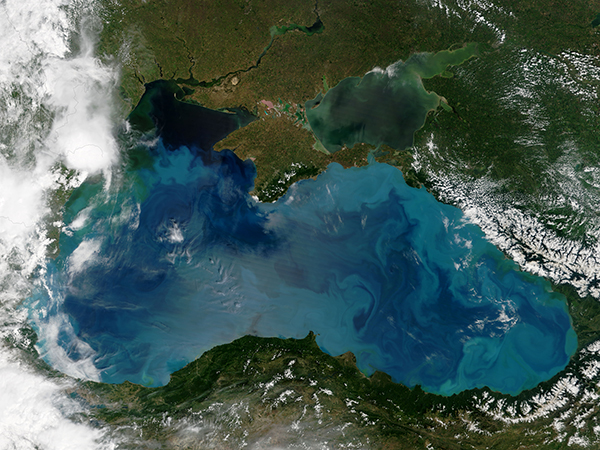Images
June 10, 2017 - Phytoplankon blooms in the Black Sea
Tweet
The spring phytoplankton blooms in the Black Sea continued to expand in the first week of June 2017. The Moderate Resolution Imaging Spectroradiometer (MODIS) aboard NASA’s Terra satellite captured this true-color image on June 8.
Phytoplankton are floating, microscopic organisms that make their own food from sunlight and dissolved nutrients. Here, ample water flow from rivers like the Danube and Dnieper carriers nutrients to the Black Sea. In general, phytoplankton support fish, shellfish, and other marine organisms. When blooms are too frequent or too expansive they also can cause eutrophication – the loss of oxygen from the water. Low oxygen levels can cause die-offs of marine life.
The milky coloration which can be seen so richly in these blooms are likely due to the growth of a particular phytoplankton called a coccolithophore. This particular organism is plated with white calcium carbonate and, when present in large numbers tend to turn the water a milky sheen.
Image Facts
Satellite:
Terra
Date Acquired: 6/8/2017
Resolutions:
1km (326.7 KB), 500m (1.1 MB), 250m (2.8 MB)
Bands Used: 1,4,3
Image Credit:
Jeff Schmaltz, MODIS Land Rapid Response Team, NASA GSFC
Tweet
The spring phytoplankton blooms in the Black Sea continued to expand in the first week of June 2017. The Moderate Resolution Imaging Spectroradiometer (MODIS) aboard NASA’s Terra satellite captured this true-color image on June 8.
Phytoplankton are floating, microscopic organisms that make their own food from sunlight and dissolved nutrients. Here, ample water flow from rivers like the Danube and Dnieper carriers nutrients to the Black Sea. In general, phytoplankton support fish, shellfish, and other marine organisms. When blooms are too frequent or too expansive they also can cause eutrophication – the loss of oxygen from the water. Low oxygen levels can cause die-offs of marine life.
The milky coloration which can be seen so richly in these blooms are likely due to the growth of a particular phytoplankton called a coccolithophore. This particular organism is plated with white calcium carbonate and, when present in large numbers tend to turn the water a milky sheen.
Image Facts
Satellite:
Terra
Date Acquired: 6/8/2017
Resolutions:
1km (326.7 KB), 500m (1.1 MB), 250m (2.8 MB)
Bands Used: 1,4,3
Image Credit:
Jeff Schmaltz, MODIS Land Rapid Response Team, NASA GSFC




